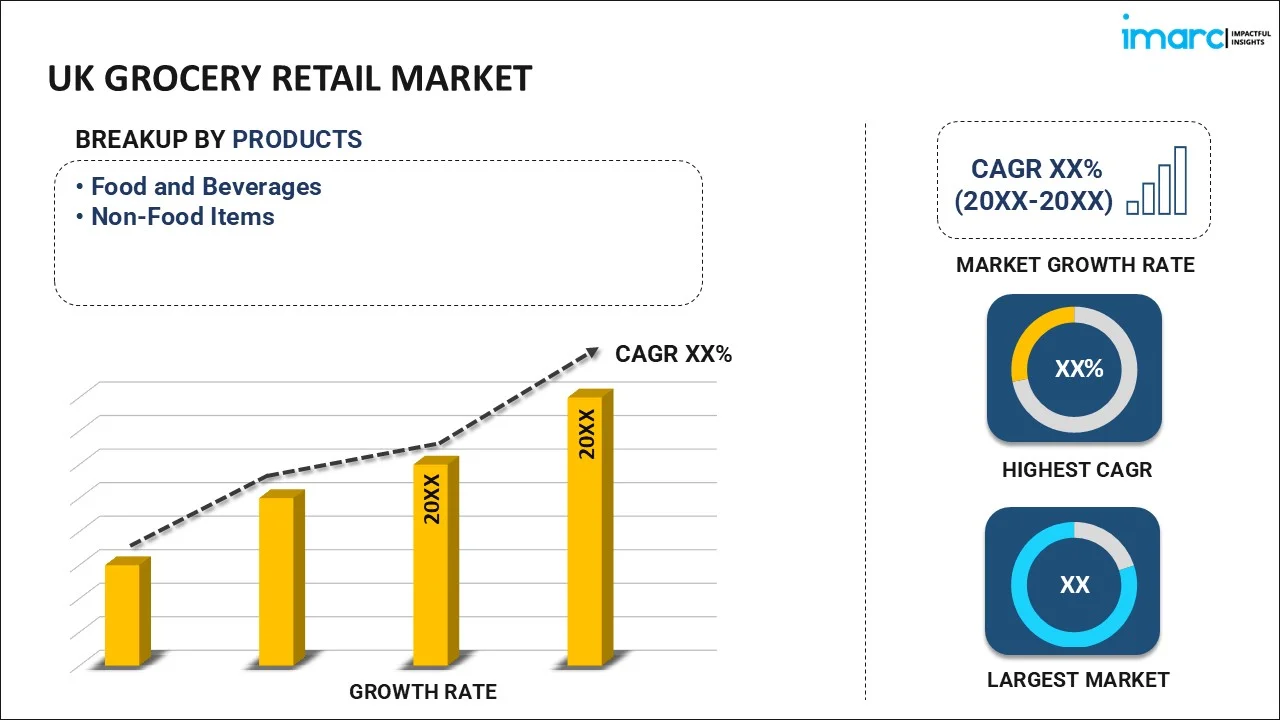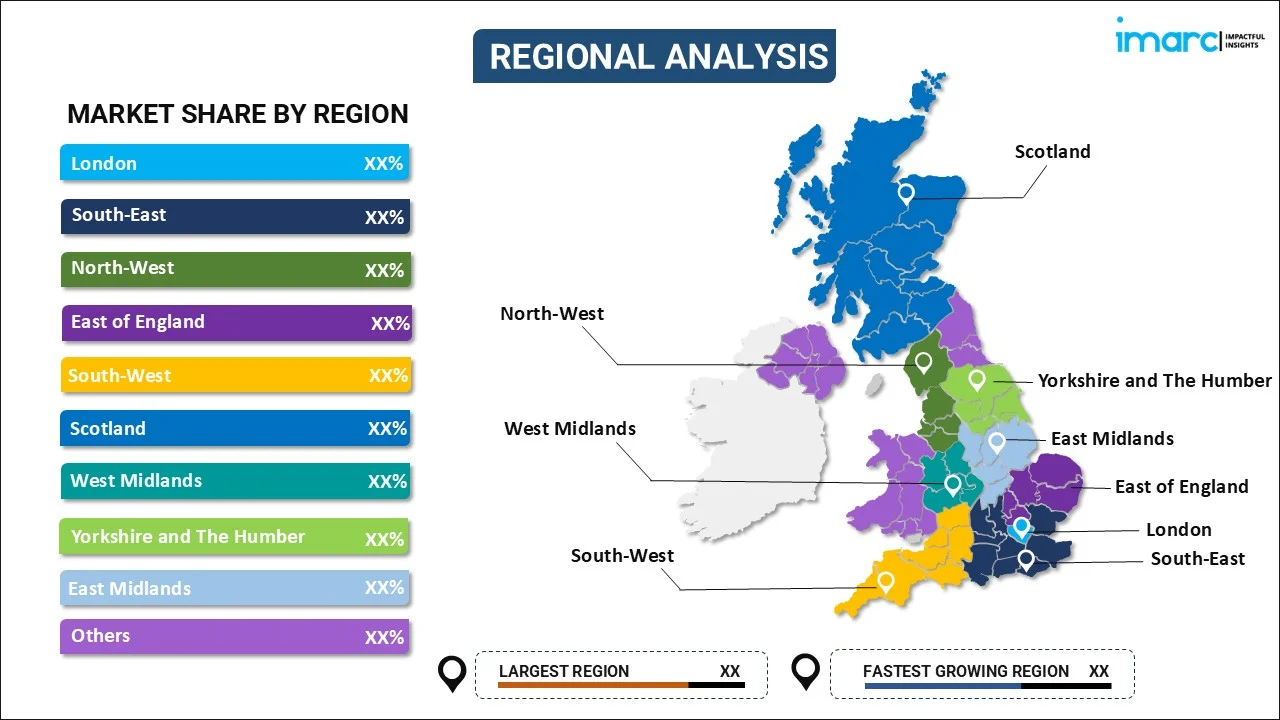
UK Grocery Retail Market Report by Product (Food and Beverages, Non-Food Items), Distribution Channel (Hypermarkets and Supermarkets, Convenience Stores, Discount Stores, Online, and Others), and Region 2025-2033
UK Grocery Retail Market Overview:
The UK grocery retail market size reached USD 294 Billion in 2024. Looking forward, IMARC Group expects the market to reach USD 354 Billion by 2033, exhibiting a growth rate (CAGR) of 2.10% during 2025-2033. The market is mainly driven by the rising trend of consumers purchasing groceries online, the growing appeal of private label products, considerable growth in the online presence of major retailers, increasing adoption of cutting-edge technologies to improve customer experience, and the increased emphasis on eco-friendly and sustainable practices.
|
Report Attribute
|
Key Statistics
|
|---|---|
|
Base Year
|
2024
|
|
Forecast Years
|
2025-2033
|
|
Historical Years
|
2019-2024
|
| Market Size in 2024 | USD 294 Billion |
| Market Forecast in 2033 | USD 354 Billion |
| Market Growth Rate 2025-2033 | 2.10% |
UK Grocery Retail Market Trends:
Rising Prevalence of Online Grocery Shopping
The online grocery shopping industry in the UK has seen significant expansion, especially following the COVID-19 pandemic. As consumers increasingly opt for the convenience and safety of digital platforms, retailers have responded by significantly expanding their online product offerings and services. The integration of AI-driven recommendation systems and the development of intuitive mobile applications have enhanced the shopping experience, making it more personalized and efficient. Furthermore, the emergence of direct-to-consumer models and subscription services is reshaping consumer interactions with brands, particularly in the online grocery sector. This trend is expected to persist, with UK retailers continually innovating to meet changing consumer preferences and demands.
Increasing Emphasis on Eco-Friendly Practices
The UK grocery retail market is witnessing a significant shift towards sustainability, primarily driven by rising consumer awareness and a growing demand for environmentally responsible products. Retailers are increasingly implementing eco-friendly initiatives, such as minimizing plastic packaging, prioritizing the sourcing of local and organic goods, and enhancing energy efficiency across their operations. Reusable packaging schemes have been introduced by many supermarkets, with customers encouraged to bring their own bags. Additionally, the expanding range of plant-based and sustainably sourced food options reflects a broader consumer shift towards healthier and more eco-conscious choices. The commitment to sustainability is driven not only by consumer demand but also by retailers' broader corporate social responsibility (CSR) efforts, as they aim to align with global environmental goals and strengthen their brand reputation.
Growing Popularity of Private Label Products
A notable increase in the popularity of private label products is being observed in the UK grocery retail market, as consumers seek high-quality, cost-effective alternatives to branded goods. In response, retailers are expanding their private label offerings across various categories, including premium and organic lines. These products often yield better margins for retailers while delivering value for money to consumers. The growing focus on store brands is a strategic tactic used by retailers to gain exclusivity and stand out in a highly competitive market. Supermarkets are investing in innovations and quality to enhance their private label ranges, making them more attractive to discerning shoppers. As inflationary pressures and economic uncertainties persist, the demand for affordable yet high-quality private label products are expected to keep rising, solidifying their market position.
UK Grocery Retail Market News:
- February 5, 2024: Asda announced plans to open 110 convenience outlets as part of its strategy to become the UK's second-largest supermarket retailer. This initiative involves the rebranding of 109 existing stores acquired from the Co-op and EG Group to its Asda Express brand, alongside opening one new store. The majority of these locations will be in southern England, where Asda has traditionally had limited representation, as part of a multimillion-pound investment aimed at rebranding all 470 acquired convenience stores under the Asda Express name by the end of March.
- May 29, 2023: Aldi plans to open four new stores in London by the end of 2024, creating over 150 jobs as part of its ongoing strategy to provide lower food prices across the capital. This expansion is part of a broader initiative to open 100 more stores in London, contributing to its long-term goal of creating around 3,500 new jobs and investing £550 million to expand its UK footprint this year. Upcoming store openings include locations in Leytonstone and Beckton in the next few months, followed by new sites on Holloway Road and Muswell Hill.
UK Grocery Retail Market Segmentation:
IMARC Group provides an analysis of the key trends in each segment of the market, along with forecasts at the country level for 2025-2033. Our report has categorized the market based on product and distribution channel.
Product Insights:

- Food and Beverages
- Fresh Food
- Packaged Food
- Beverages
- Non-Food Items
- Household Cleaning Products
- Personal Care Products
- Pet Care Products
The report has provided a detailed breakup and analysis of the market based on the product. This includes food and beverages (fresh food, packaged food, and beverages) and non-food items (household cleaning products, personal care products, and pet care products).
Distribution Channel Insights:
- Hypermarkets and Supermarkets
- Convenience Stores
- Discount Stores
- Online
- Others
A detailed breakup and analysis of the market based on the distribution channel have also been provided in the report. This includes hypermarkets and supermarkets, convenience stores, discount stores, online, and others.
Regional Insights:

- London
- South East
- North West
- East of England
- South West
- Scotland
- West Midlands
- Yorkshire and The Humber
- East Midlands
- Others
The report has also provided a comprehensive analysis of all the major regional markets, which include London, South East, North West, East of England, South West, Scotland, West Midlands, Yorkshire and The Humber, East Midlands, and Others.
Competitive Landscape:
The market research report has also provided a comprehensive analysis of the competitive landscape. Competitive analysis such as market structure, key player positioning, top winning strategies, competitive dashboard, and company evaluation quadrant has been covered in the report. Also, detailed profiles of all major companies have been provided.
UK Grocery Retail Market Report Coverage:
| Report Features | Details |
|---|---|
| Base Year of the Analysis | 2024 |
| Historical Period | 2019-2024 |
| Forecast Period | 2025-2033 |
| Units | USD Billion |
| Scope of the Report | Exploration of Historical Trends and Market Outlook, Industry Catalysts and Challenges, Segment-Wise Historical and Future Market Assessment:
|
| Products Covered |
|
| Distribution Channels Covered | Hypermarkets and Supermarkets, Convenience Stores, Discount Stores, Online, Others |
| Regions Covered | London, South East, North West, East of England, South West, Scotland, West Midlands, Yorkshire and The Humber, East Midlands, Others |
| Customization Scope | 10% Free Customization |
| Post-Sale Analyst Support | 10-12 Weeks |
| Delivery Format | PDF and Excel through Email (We can also provide the editable version of the report in PPT/Word format on special request) |
Key Questions Answered in This Report:
- How has the UK grocery retail market performed so far and how will it perform in the coming years?
- What has been the impact of COVID-19 on the UK grocery retail market?
- What is the breakup of the UK grocery retail market on the basis of product?
- What is the breakup of the UK grocery retail market on the basis of distribution channel?
- What are the various stages in the value chain of the UK grocery retail market?
- What are the key driving factors and challenges in the UK grocery retail?
- What is the structure of the UK grocery retail market and who are the key players?
- What is the degree of competition in the UK grocery retail market?
Key Benefits for Stakeholders:
- IMARC’s industry report offers a comprehensive quantitative analysis of various market segments, historical and current market trends, market forecasts, and dynamics of the UK grocery retail market from 2019-2033.
- The research report provides the latest information on the market drivers, challenges, and opportunities in the UK grocery retail market.
- Porter's five forces analysis assist stakeholders in assessing the impact of new entrants, competitive rivalry, supplier power, buyer power, and the threat of substitution. It helps stakeholders to analyze the level of competition within the UK grocery retail industry and its attractiveness.
- Competitive landscape allows stakeholders to understand their competitive environment and provides an insight into the current positions of key players in the market.
Need more help?
- Speak to our experienced analysts for insights on the current market scenarios.
- Include additional segments and countries to customize the report as per your requirement.
- Gain an unparalleled competitive advantage in your domain by understanding how to utilize the report and positively impacting your operations and revenue.
- For further assistance, please connect with our analysts.
 Inquire Before Buying
Inquire Before Buying
 Speak to an Analyst
Speak to an Analyst
 Request Brochure
Request Brochure
 Request Customization
Request Customization




.webp)




.webp)












